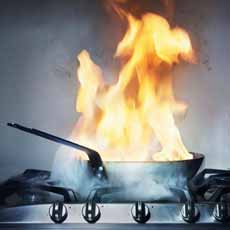TIP OF THE DAY: 8 Tips To Prevent Kitchen Fires
 [1] Don’t let this happen. See tip #1 (photo courtesy Stone Frying Pans).
[3] Tip #8: Be sure you have a kitchen fire alarm…and that its batteries are fresh (photo courtesy Thrifty Fun). |
Fire Prevention Week begins October 7th and, according to the National Fire Protection Association (NFPA), cooking is the leading cause of home fires. In 40% of the cases, believe it or not, people have forgotten to turn off a stove or oven (source: 2017 American Red Cross survey last). We can believe it. We’ve caused two microwave fires and one stove top fires for stupid behavior: leaving the kitchen while food is cooking. That’s tip #1, below. The American Red Cross shared more tips to stay safe from cooking-related fires. 1. Don’t leave the kitchen when frying, grilling or broiling food. (Or microwaving, per our experience, since we burned out the microwaves by accidentally punching in 40 minutes instead of 4 minutes. Then we left the room, planning to come back when it was done. We got waylaid; the food combusted long before it got to 40 minutes. The smoke alarm tipped us off.) 2. Don’t leave the house when simmering, baking, roasting or boiling food. 3. Keep the stove area clean and clear of things that can catch fire, such as pot holders, towels, curtains, bags, and other appliances. 4. Keep pets away from cooking surfaces and countertops. 5. Be sure your home smoke alarm is working. 5. If a fire starts in a pan, slide a lid over the burning pan and turn off the burner. Leave the lid in place until the pan is completely cool. Moving the pan can cause serious injury or spread the fire. 6. Never pour water on grease fires. Two tips from THE NIBBLE: 7. Keep an easy-to-use aerosol fire extinguisher next to the stove. THE NIBBLE uses The First Alert Tundra Fire Extinguisher 8. Test your smoke alarm to be sure it’s working. Don’t have a smoke alarm in or just outside of the kitchen? Get one ASAP! If your fire is out of control, exit the residence immediately and call 911 from outside the house. Experts say that today’s home fires burn faster than ever, leaving people with as little as two minutes to escape a burning residence. But many mistakenly believe they have more time. Share these tips with everyone in your household. How to Test and Install a Smoke Alarm (video) |
|
|
|
||

